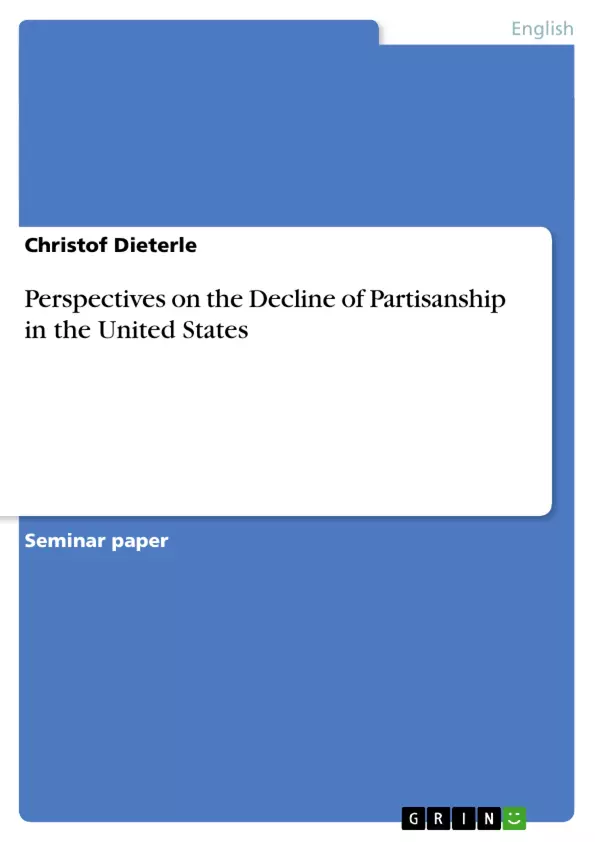The question which role parties have in political life in the United States has concerned scholars for more than a century. Beginning with the introduction of the first statewide primaries in South Carolina in 1896, when the power of candidate nomination was taken away from party bosses and transferred to all party members or affiliates, there is a te ndency that parties lose influence not only in elections and other political processes, but also in everyday life in the United States. In this paper I will try to draw a rough outline of the discussion that has taken place in the last decades in order to give an overview on different theoretical approaches to the decline of party identification as well as on some of the consequences of this development. Naturally, this paper cannot deal with many other aspects of party identification, e.g. drawn from modernization theory or psychology.1 But, despite these limitations, the results presented in the concluding chapter provide some evidence for the thesis that U.S. Parties are in a state of decline and that this decline can have severe impacts on U.S. political and social life.
This paper is structured as follows: In chapter 2, I will draw an outline of the different theoretical approaches to the concept of partisanship, ranging from socio-psychological attachment to Rational Choice theory and Multidimensional approaches. Chapter 3 is the longest part of this paper and deals with the reasons for the decline of party identification. After discussing some empirical data, I will turn to socio-economic factors leading to partisan dealignment before analysing the rise of issue and candidate voting. In chapter 4 I will present a brief outlook on some of the consequences of the decline of party identification on different levels of political and social life in the United States. The last chapter consists of a short summary of the findings of this paper and some concluding remarks.
Inhaltsverzeichnis (Table of Contents)
- Introduction
- The concept of partisanship
- Different views on party identification - The Michigan School
- Different views on party identification - Rational Choice Models
- Explaining the decline of partisanship
- Empirical Data
- Socio-economic factors and party identification
- The rise of issue voting and candidate voting
- Consequences of the decline of party identification
Zielsetzung und Themenschwerpunkte (Objectives and Key Themes)
This paper aims to provide an overview of the scholarly discussion surrounding the decline of party identification in the United States. It explores different theoretical approaches to explaining this phenomenon, analyzes the empirical data related to the decline, and discusses the potential consequences of this trend on American political and social life.
- The concept of partisanship and different theoretical approaches to understanding it.
- The decline of party identification in the United States and its underlying causes.
- Socio-economic factors influencing party identification and their impact on partisan dealignment.
- The emergence of issue and candidate voting as alternative forms of political engagement.
- The consequences of the decline of party identification on American politics and society.
Zusammenfassung der Kapitel (Chapter Summaries)
- Introduction: This chapter introduces the topic of party identification in the United States, highlighting the decline of party influence in recent decades. It provides a brief overview of the paper's structure and research objectives.
- The concept of partisanship: This chapter examines the concept of partisanship, or party identification, in the United States, contrasting it with party structures in other countries. It explores different theoretical perspectives, including the socio-psychological attachment model (The Michigan School) and Rational Choice theory, which emphasize the role of information shortcuts in party identification.
- Explaining the decline of partisanship: This chapter focuses on the reasons for the decline in party identification. It presents empirical data illustrating the trend and discusses socio-economic factors contributing to partisan dealignment. It further analyzes the rise of issue and candidate voting as alternatives to traditional party-based political participation.
Schlüsselwörter (Keywords)
This paper focuses on the concepts of partisanship, party identification, and their decline in the United States. It explores theoretical perspectives such as the Michigan School, Rational Choice theory, and the role of information shortcuts in political behavior. The analysis includes discussions of socio-economic factors, issue voting, candidate voting, and the potential consequences of partisan dealignment on American politics and society.
- Citation du texte
- Christof Dieterle (Auteur), 2004, Perspectives on the Decline of Partisanship in the United States, Munich, GRIN Verlag, https://www.grin.com/document/29748



